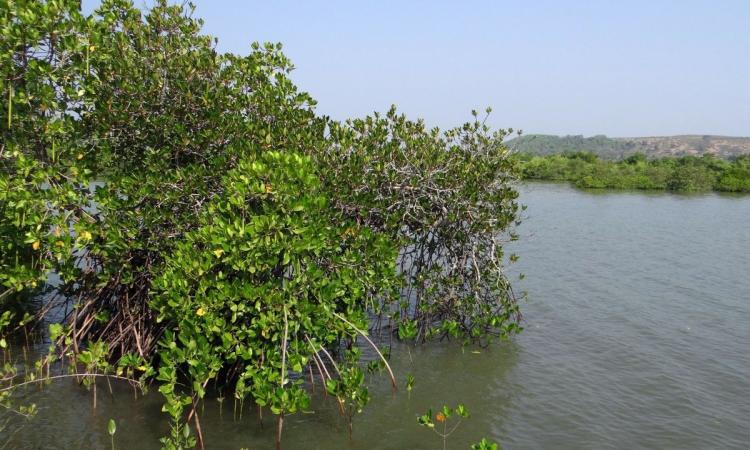
Since 2019, the United Nations Environment Programme (UNEP) in-collaboration with Partners for Resilience (PfR) have developed and implemented scalable Ecosystem-based Disaster Risk Reduction (Eco-DRR) models, working alongside various governments and their respective communities in strengthening their capacity and shaping Eco-DRR policy interventions.
This case study highlights Eco-DRR interventions in India focused on integrating Eco-DRR measures on improved water management into local development plans and schemes (such as disaster, wetlands and rural employment) through capacity-strengthening and participation of communities and (local) governments.
The key risk being addressed within this context is how wetland degradation reduces community resilience against water-related hazards such as floods, droughts, and storm surges. To address this, the project aims to strengthen resilience of 60,000 women and men to water-related risks and national upscaling model for improved water management focusing in 3 key project sites: Tampara Wetland (Odisha), Kabartal Wetland (Bihar), and a northern dryland region in Gujarat.
A model for upscaling community resilience has been developed through three core components of Eco-DRR: Ecosystem Restoration/Protection, Disaster Risk Reduction, and Climate Smart Livelihoods. In India, there is a greater emphasis on Ecosystem Restoration and Protection through a focus on water related, risk sensitive wetlands restoration and capacity building activities.
The project has reached 29,216 beneficiaries, out of which 36% were women. 32 Community-based Organisations were trained on Eco-DRR and 224 women (members of Self-Help Groups) were trained on sustainable livelihoods and wetland wise use, among other capacity building achievements. 3,312 hectares (ha) of wetlands and community common pool resources (ponds, drainages) have now been protected and restored.
A Cost-Benefit Analysis (CBA) performed by the University of Massachusetts Amherst demonstrated that the benefits of Eco-DRR and resilience enhancement interventions outweigh the value of their initial costs. Integration of both Eco-DRR and wetlands conservation in the operations of technical institutions, local CSOs and Community-based Organisations will ensure sustainability of results.
Project lessons learned
- Understanding the local context (historical, socio-economic, level of knowledge and attitude, etc.) is essential to ensure community engagement and secure ownership. This was done through baseline surveys, participatory risk profiling, and ecosystem services assessment. The results helped in devising Eco-DRR interventions, which are supported by the local communities.
- Adoption of hybrid solutions (grey and green structures) are the most appropriate resilience building measures as communities at-risk accorded higher scores for specific structural mitigation and also appreciated the roles of ecosystems and non-structural measures in reducing exposures & vulnerabilities.
- Identifying community-based volunteers and organisations to champion Eco-DRR has been effective in successful project implementation. Similarly, partnerships with landscape-based NGOs and knowledgeable local partners helped in developing Eco-DRR conscious wetlands management plans.
- Review of existing sectoral plans that guide developmental actions in the landscape was helpful in identifying entry points for Eco-DRR and its upscaling.
Gender Mainstreaming
Gender mainstreaming has been a vital component of Eco-DRR implementation in India, taking into consideration the gender nuances in India, which is very diverse from area to area. Engagement with male and female community members in planning and implementing Eco-DRR measures has been strategic and progressive. The project engaged with women as community members, female members of Panchayat Raj Institution/Local Self-Government, female school students, and various women-centric Community-based Organisations such as Self-Help Groups.
This is to ensure their opinions, views and suggestions are reflected in baseline surveys, training, and implementing Eco-DRR actions. Women have a growing interest in participating in the decision-making process of local development plans (ward and Panchayat levels). It is necessary to engage with a local CSO partner on gender mainstreaming efforts at an early stage.
Recommendations for upscaling
- Build convergence between Eco-DRR and relevant developmental programs and schemes of the government to secure political leverage, funds, and cross-sectoral support.
- Establishing proof of concepts through extensive research on the roles of healthy wetland ecosystems in reducing disaster risks and managing climate risks.
- Establishing and advocating a plausible business case for Eco-DRR, which could be done through economic valuation of medium- and long-term advantages of Eco-DRR (cost and benefit analysis).
- Establishing a country-wide network of Eco-DRR or NbS experts, generating knowledge products and policy recommendations to pursue its upscaling in relevant policies and programs.
Recommendations for future Eco-DRR projects
- Designation of wetlands as protected areas (e.g Ramsar site) will ensure the conservation and management of this ecosystem with the best of available resources and political will.
- Integration of Eco-DRR actions into wetlands management plans shall have an adequate emphasis on institutional arrangements, wetland monitoring, and community participation to nurture wetland ecosystem services and address climate and disaster-related risks.
- Development of training manual and imparting Eco-DRR knowledge to local Disaster Management Authorities will facilitate the integration of this approach into their planning and actions.
- Integration of both Eco-DRR and wetlands conservation in the operations of technical institutions, local CSOs and Community-based Organisations will ensure sustainability of results.
This case study lays the foundation for demonstrating the need for large-scale implementation of Eco-DRR in advancing the implementation of the Sendai Framework for Disaster Risk Reduction and the Sustainable Development Agenda. The content for this case study has been developed by the United Nations Environment Programme (UNEP) in collaboration with Partners for Resilience (PfR) – a global alliance between the Netherlands Red Cross, the Red Crossand Red Crescent Climate Center, Cordaid, Wetlands International, and CARE along with partner civil society organisations in the countries where they work.
The full report can be accessed here